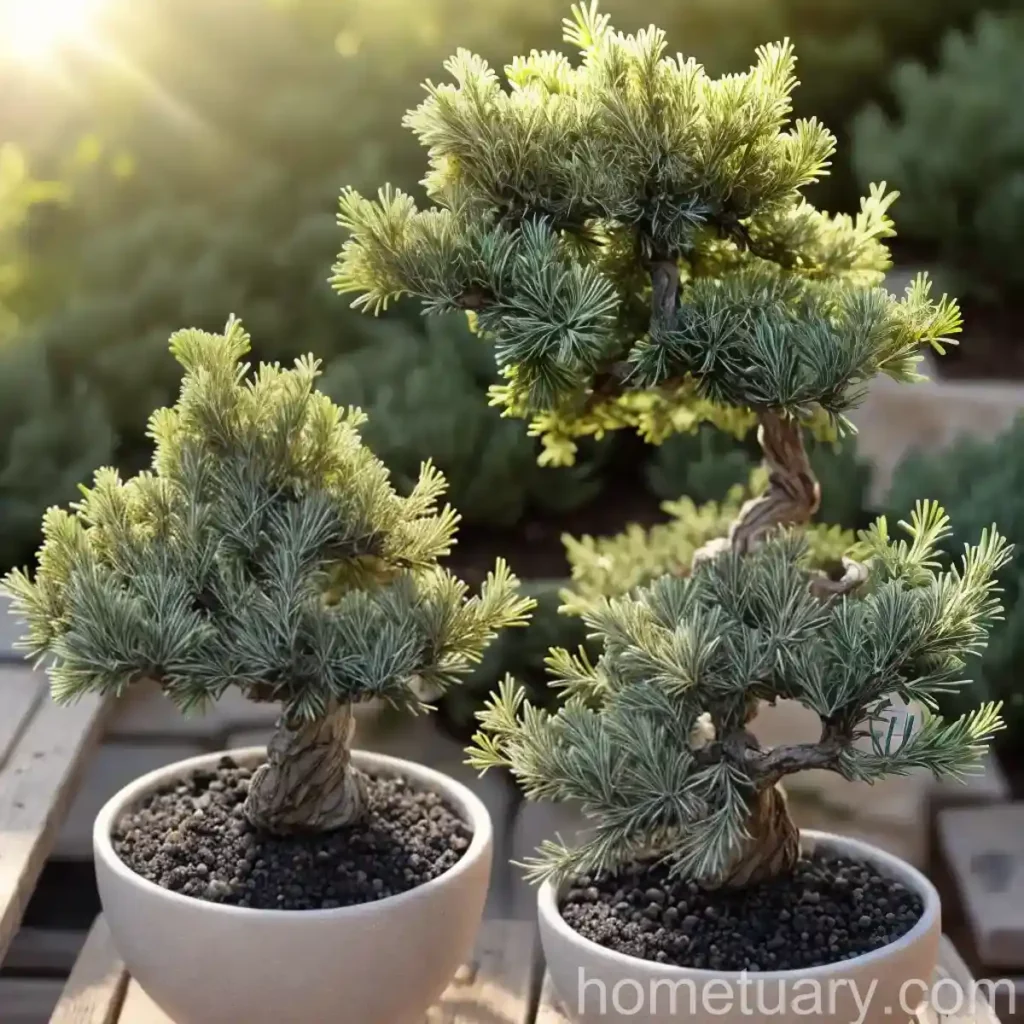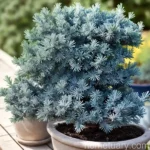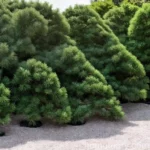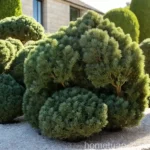Juniper (Juniperus x pfitzeriana ‘Saybrook Gold’) – A Complete Guide for Cultivation and Care
Junipers are a popular choice for gardens and landscapes, known for their evergreen foliage and low-maintenance requirements. Among the diverse juniper varieties available today, one standout cultivar is the Juniperus x pfitzeriana ‘Saybrook Gold’, notable for its vibrant golden-yellow foliage. In this comprehensive guide, we will delve into the culture, uses, cultivation, and care of the Juniperus x pfitzeriana ‘Saybrook Gold’, offering valuable insights for both novice and experienced gardeners.
What is Juniperus x pfitzeriana ‘Saybrook Gold’?
Juniperus x pfitzeriana ‘Saybrook Gold’, commonly referred to as Saybrook Gold juniper, is a cultivar of the Pfitzer Juniper, which is a hybrid between Juniperus chinensis and Juniperus sabina. This evergreen shrub is prized for its striking golden-yellow foliage, making it a sought-after ornamental plant in landscaping and garden design.
Key Takeaways
Before delving into the details of cultivation and care, let’s highlight some key takeaways about the Juniperus x pfitzeriana ‘Saybrook Gold’:
- Scientific Name: Juniperus x pfitzeriana ‘Saybrook Gold’
- Common Name: Saybrook Gold Juniper
- Foliage Color: Golden-yellow
- Growth Habit: Compact, spreading
- Sunlight: Full sun to partial shade
- Watering: Moderate
- Soil Type: Well-draining
- Uses: Ornamental, ground cover, mass planting, landscaping
- Hardiness Zone: 4-9
- Mature Height: 2-3 feet
- Mature Spread: 4-6 feet
- Maintenance: Low
- Common Pests: Generally pest-resistant
- Common Diseases: Minimal disease susceptibility
Now, let’s explore the detailed aspects of the cultivation and care of Juniperus x pfitzeriana ‘Saybrook Gold’.
Culture of Juniperus x pfitzeriana ‘Saybrook Gold’
Cultivating Juniperus x pfitzeriana ‘Saybrook Gold’ involves understanding its cultural requirements, including water, sunlight, soil, and fertilization needs. By providing the ideal growing conditions, gardeners can ensure the health and vitality of this vibrant ornamental shrub.
Water
Proper watering is crucial for the establishment and growth of Juniperus x pfitzeriana ‘Saybrook Gold’. While these junipers are relatively drought-tolerant once established, consistent moisture is essential, particularly during the initial establishment phase. Adequate watering helps promote healthy root development and lush foliage.
- Young Plants: Water regularly and deeply during the first year after planting to aid in root establishment.
- Established Plants: Once established, water during extended dry periods to prevent drought stress. However, ensure that the soil is well-draining to avoid waterlogged conditions, which can be detrimental to junipers.
Sunlight
Juniperus x pfitzeriana ‘Saybrook Gold’ thrives in locations with ample sunlight, although it can tolerate partial shade. When selecting a planting site, prioritize areas with full sun exposure to encourage optimal growth and vibrant foliage color. Adequate sunlight promotes the development of the characteristic golden-yellow tones, enhancing the visual appeal of the shrub.
- Full Sun: Plant in areas with at least 6-8 hours of direct sunlight per day for the best foliage color and overall vigor.
- Partial Shade: While tolerant of partial shade, reduced sunlight may result in slightly muted foliage color and slower growth.
Fertilizer
Fertilization plays a vital role in supporting the growth and vitality of Juniperus x pfitzeriana ‘Saybrook Gold’. However, these junipers are generally considered low-maintenance and have modest fertility requirements. Incorporate fertilizer application into the overall maintenance routine to provide essential nutrients for robust growth and vibrant foliage.
- Timing: Apply a balanced, slow-release fertilizer in early spring before the onset of new growth.
- Frequency: Fertilize once per year, as excessive fertility can potentially harm the plant.
- Application: Distribute the fertilizer evenly in the root zone, following the recommended rates specific to ornamental shrubs.
Soil Requirements for Juniperus x pfitzeriana ‘Saybrook Gold’
Selecting the right soil type and ensuring proper soil conditions are essential for the successful cultivation of Juniperus x pfitzeriana ‘Saybrook Gold’. Well-draining soil is particularly critical to prevent waterlogging and root rot, safeguarding the overall health of the juniper.
Soil Type
Juniperus x pfitzeriana ‘Saybrook Gold’ thrives in well-draining soil with a slightly acidic to neutral pH. Additionally, the soil should offer good aeration and moisture retention while preventing excessive water retention around the roots.
- Ideal Soil: Sandy loam or loamy soil with good drainage characteristics is well-suited for growing Juniperus x pfitzeriana ‘Saybrook Gold’.
- Soil Amendments: Organic matter, such as compost, can be incorporated into the soil to improve its structure and fertility.
Drainage
Effective drainage is crucial for preventing waterlogged conditions, which can be detrimental to junipers. Suitable drainage ensures that excess water can freely move away from the root zone, reducing the risk of root diseases and other related issues.
- Slope and Elevation: Plant Juniperus x pfitzeriana ‘Saybrook Gold’ in elevated or slightly sloped areas to promote natural drainage.
- Avoid Compaction: Minimize soil compaction, especially in heavy clay soils, to maintain adequate drainage capabilities.
Pruning and Maintenance of Juniperus x pfitzeriana ‘Saybrook Gold’
Pruning and maintenance practices are integral to shaping, rejuvenating, and preserving the aesthetic appeal of Juniperus x pfitzeriana ‘Saybrook Gold’. By following proper pruning techniques and incorporating routine maintenance, gardeners can ensure that the shrub maintains its desired form and remains healthy throughout the seasons.
Pruning
Regular pruning helps manage the size, shape, and density of Juniperus x pfitzeriana ‘Saybrook Gold’, promoting a compact and well-groomed appearance. Proper timing and techniques are essential for successful pruning without compromising the plant’s health.
- Timing: Prune in early spring before the onset of new growth for routine maintenance. Avoid pruning in late fall, as it may interfere with the plant’s dormancy and winter hardiness.
- Techniques: Use sharp, clean pruning tools to make precision cuts, removing dead, damaged, or overgrown branches while maintaining the shrub’s natural form.
- Thinning: Periodic thinning of the foliage can improve air circulation and light penetration, reducing the risk of disease and promoting overall vigor.
Maintenance
In addition to pruning, general maintenance practices contribute to the overall health and appearance of Juniperus x pfitzeriana ‘Saybrook Gold’. Regular upkeep, including monitoring for pests and diseases, supports the long-term well-being of the plant.
- Weed Control: Keep the area around the juniper free from weeds that can compete for resources and hinder growth.
- Pest Inspection: Regularly inspect the foliage for signs of pest infestations, addressing any issues promptly to prevent damage.
- Disease Monitoring: Monitor the shrub for any symptoms of diseases, such as discoloration or abnormal growth, and take appropriate measures when necessary.
Propagation of Juniperus x pfitzeriana ‘Saybrook Gold’
Propagation allows gardeners to expand their Juniperus x pfitzeriana ‘Saybrook Gold’ collection or share the vibrant beauty of this cultivar with others. While junipers can be propagated through various methods, understanding the specific techniques for ‘Saybrook Gold’ is essential for successful reproduction.
Seed Propagation
Growing Juniperus x pfitzeriana ‘Saybrook Gold’ from seeds is possible, but it requires patience and careful attention to the specific germination requirements of juniper seeds.
- Seed Collection: Harvest mature juniper seeds from the shrub in the fall and prepare them for propagation.
- Seed Treatment: Certain juniper seeds may benefit from stratification, a cold treatment designed to enhance germination.
- Germination: Sow the prepared seeds in a suitable seed-starting mix and provide the ideal conditions for germination.
Cuttings
Propagating Juniperus x pfitzeriana ‘Saybrook Gold’ through cuttings offers a reliable method to produce genetically identical offspring, preserving the unique characteristics of the cultivar.
- Softwood Cuttings: Take softwood cuttings in early summer when the new growth is still flexible and actively growing.
- Preparation: Treat the cuttings with rooting hormone and plant them in a well-draining rooting medium to encourage root development.
- Rooting: Provide consistent moisture and humidity to support the successful rooting of the cuttings.
Juniperus x pfitzeriana ‘Saybrook Gold’ in Containers
The compact size and ornamental appeal of Juniperus x pfitzeriana ‘Saybrook Gold’ make it well-suited for container cultivation, offering versatility in garden design and landscaping.
Container Selection
When growing Juniperus x pfitzeriana ‘Saybrook Gold’ in containers, choosing the right pot or planter is crucial for providing adequate space for root development and stability for the shrub.
- Size: Select a container with sufficient depth and width to accommodate the root system and allow for future growth.
- Drainage: Ensure that the container has drainage holes to prevent waterlogging and root rot.
Care Considerations
Container-grown junipers may have distinct care requirements compared to those planted in the ground. Proper attention to watering, fertilization, and overall maintenance is essential for the health and vitality of Juniperus x pfitzeriana ‘Saybrook Gold’.
- Watering: Monitor the moisture levels in the container and water when the top inch of the soil feels dry, adjusting frequency based on environmental conditions.
- Fertilization: Apply a balanced, slow-release fertilizer to container-grown junipers in spring, following the recommended rates for potted plants.
- Root Bound: Regularly inspect the roots and consider repotting the shrub if it becomes root-bound, showing signs of restricted growth.
Popularity of Juniperus x pfitzeriana ‘Saybrook Gold’
Juniperus x pfitzeriana ‘Saybrook Gold’ has gained popularity among gardeners and landscapers for its distinctive foliage color, compact habit, and versatile uses in various garden settings.
- Landscape Use: The vibrant golden-yellow foliage of ‘Saybrook Gold’ juniper adds visual interest to mixed borders, rock gardens, and foundation plantings.
- Mass Planting: The compact and spreading growth habit makes this cultivar well-suited for mass planting, creating striking ground cover and continuity in the landscape.
- Ornamental Value: The year-round appeal of the golden foliage, coupled with minimal maintenance requirements, contributes to the overall desirability of this juniper cultivar.
Common Diseases of Juniperus x pfitzeriana ‘Saybrook Gold’
While Juniperus x pfitzeriana ‘Saybrook Gold’ is relatively resistant to diseases, certain environmental conditions and factors may predispose the shrub to specific issues. Understanding common diseases and their preventive measures is essential for maintaining the health and vigor of the plant.
Disease Diagnosis
Identifying symptoms and signs of potential diseases in Juniperus x pfitzeriana ‘Saybrook Gold’ allows for prompt intervention and appropriate management strategies.
- Needle Discoloration: Monitor the foliage for any discoloration, browning, or yellowing, which may indicate disease or environmental stress.
- Dieback: Check for any dieback of branches or tips, which can be a sign of fungal infections or other pathogenic issues.
- Fungal Growth: Examine the juniper for any abnormal fungal growth, such as powdery mildew or rust, which can affect the foliage and overall health of the plant.
Disease Prevention
Preventive measures and cultural practices play a key role in mitigating the risk of diseases in Juniperus x pfitzeriana ‘Saybrook Gold’, promoting resilience and vitality.
- Pruning Practices: Regular pruning to maintain good airflow and light penetration can reduce the risk of fungal diseases by creating an unfavorable environment for pathogen development.
- Sanitation: Remove and dispose of any diseased plant material promptly to prevent the spread of pathogens to healthy parts of the shrub.
- Proper Watering: Avoid overwatering, as excessive moisture can create conditions favorable for certain fungal diseases, such as root rot and blight.
Common Pests Affecting Juniperus x pfitzeriana ‘Saybrook Gold’
Juniperus x pfitzeriana ‘Saybrook Gold’ exhibits a degree of resilience against many common pests; however, certain insects may occasionally pose a threat. Vigilance and early intervention can help safeguard the juniper from potential pest damage.
Pest Identification
Recognizing the signs and symptoms of common pests affecting Juniperus x pfitzeriana ‘Saybrook Gold’ is crucial in implementing appropriate pest management strategies.
- Spider Mites: Look for webbing and stippling on the foliage, as spider mite infestations can cause discoloration and reduced vigor.
- Bagworms: Monitor for the presence of bagworm cocoons attached to the branches, as they can defoliate the juniper if left unchecked.
- Scale Insects: Inspect the branches for scale insects, characterized by their small, waxy coverings, which can weaken the shrub by feeding on the sap.
Pest Control
Integrated pest management techniques and targeted interventions can effectively address pest issues while minimizing the use of chemical controls.
- Natural Predators: Encourage the presence of natural predators, such as ladybugs and lacewings, which feed on common pests infesting junipers.
- Horticultural Oils: Apply horticultural oils to control certain pests, targeting the vulnerable life stages of insects while minimizing impact on beneficial organisms.
- Selective Pruning: Handpick and prune affected branches to physically remove pest populations, reducing their numbers and preventing further spread.
Botanist’s Tips for Juniperus x pfitzeriana ‘Saybrook Gold’
Gaining insights from the perspective of a botanist offers valuable recommendations and strategies for successfully cultivating and caring for Juniperus x pfitzeriana ‘Saybrook Gold’. These expert tips encompass various aspects, including landscaping ideas, growth habits, and environmental considerations.
Landscaping Ideas
Utilizing the unique attributes and ornamental value of Juniperus x pfitzeriana ‘Saybrook Gold’ can enhance the visual appeal and functionality of landscape designs.
- Accent Planting: Use ‘Saybrook Gold’ juniper as a focal point or accent plant, strategically placing it to highlight its vibrant foliage in garden beds or borders.
- Rock Gardens: Incorporate this juniper cultivar into rock gardens and alpine settings to introduce color contrast and textural interest.
Growth Habits
Understanding the growth habits and developmental characteristics of Juniperus x pfitzeriana ‘Saybrook Gold’ aids in planning and maintaining its form within the landscape.
- Spreading Form: Account for the spreading nature of ‘Saybrook Gold’ when spacing multiple plants, allowing for adequate room for expansion and coverage.
- Slow Growth: Recognize the relatively slow growth rate of the shrub, particularly in the early years, when planning for landscape establishment and maturity.
Environmental Considerations
Awareness of the environmental factors influencing the health and performance of Juniperus x pfitzeriana ‘Saybrook Gold’ guides gardeners in optimizing its growing conditions.
- Winter Care: Protect ‘Saybrook Gold’ juniper from winter winds and desiccation by applying a thick layer of mulch and shielding it from harsh environmental elements.
- Drought Tolerance: Capitalize on the natural drought tolerance of this juniper cultivar by integrating it into water-wise landscape designs and low-maintenance settings.
Fun Facts About Juniperus x pfitzeriana ‘Saybrook Gold’
Exploring the intriguing and lesser-known aspects of Juniperus x pfitzeriana ‘Saybrook Gold’ adds depth to the understanding and appreciation of this captivating ornamental shrub.
- Historical Significance: Juniperus species have been used for centuries, with the aromatic wood and foliage holding cultural and medicinal significance in various traditions.
- Wildlife Support: The evergreen nature of junipers, including ‘Saybrook Gold’, provides year-round shelter and cover for small wildlife and birds.
- Symbolism: Junipers have been associated with symbolism in folklore and mythology, representing protection, longevity, and resilience across different cultures.
Links to External Resources
For further exploration and in-depth information about Juniperus x pfitzeriana ‘Saybrook Gold’ and related topics, the following external resources provide valuable insights and resources:
- The American Conifer Society: Access extensive information on junipers, conifers, and ornamental shrubs, including cultivation, care guides, and expert advice.
- Royal Horticultural Society (RHS): Explore the RHS website for comprehensive plant profiles, gardening resources, and horticultural expertise.
In conclusion, Juniperus x pfitzeriana ‘Saybrook Gold’ embodies the allure of ornamental shrubs, combining striking visual appeal with low-maintenance requirements. By embracing the insights and recommendations outlined in this comprehensive guide, gardeners and enthusiasts can cultivate and care for ‘Saybrook Gold’ juniper to enhance their landscapes and gardens with its vibrant, golden-yellow foliage and enduring charm.
It is my hope that this extensive resource serves as a valuable reference for plant enthusiasts and horticultural enthusiasts, providing practical guidance and botanical appreciation for Juniperus x pfitzeriana ‘Saybrook Gold’.
I encourage you to explore the beauty and resilience of this captivating juniper cultivar, embracing its unique qualities and ornamental contributions in various garden settings.
Disclaimer: The information provided in this guide is intended for educational and informational purposes only. It is not a substitute for professional botanical or horticultural advice. Always consult with qualified professionals for guidance specific to your individual gardening and landscaping needs.















